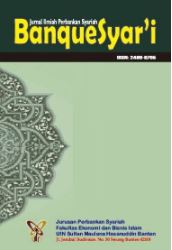PENGARUH PERPUTARAN MODAL KERJA TERHADAP RETURN ON ASSET (ROA) PADA BANK MUAMALAT INDONESIA TAHUN 2008-2017
DOI:
https://doi.org/10.32678/bs.v5i2.2530Keywords:
Working Capital Turnover, Return On Assets (ROA), Islamic BankingAbstract
Working capital is a major factor that is needed by every bank. Working capital is usually in the form of cash, receivables, securities, inventories and other current assets that will be used for daily operations. Without working capital, a bank cannot run its operations properly. The faster the working capital turnover, the better the use of working capital. This will have an impact on the acquisition of Return On Assets (ROA) at the bank. The methodology in this study uses quantitative research methods in the form of numbers and numerics with secondary data acquisition in the form of Time Series, which uses quarterly data in 2008-2017 Bank Muamalat Indonesia. The analysis technique used is simple linear regression analysis. The results of the analysis obtained from this study are the working capital turnover has a positive and significant effect on Return On Assets (ROA) at Bank Muamalat Indonesia in 2008-2017. This can be seen from the results of t-count greater than t table (2.104> 2.02439) and the significance level of 0.042 <0.05. As well as the value of the correlation coefficient of 0.327 which means the level of relationship between variables is low because it lies in the interval 0.20 - 0.399. The results of the coefficient of determination (R2) of 0.107 or 10.7%. This shows that working capital turnover has an effect of 10.7% on Return on Assets (ROA). While the remaining 89.3% is influenced by other factors or variables, such as cash turnover, inventory turnover, accounts receivable turnover, rupiah exchange rate, inflation, etc. which are not examined in this study
Downloads
References
Ghozali, Imam. 2016. Aplikasi Analisis Multivariate Dengan Program IBM SPSS 23. Semarang: UNDIP.
Halim, Abdul. 2007. Manajemen Keuangan Bisnis. Bogor: Ghalia Indonesia.
http://www.bankmuamalat.co.id, diakses pada tanggal 01 Juni 2018.
http://www.ojk.go.id, diakses pada tanggal 01 Juni 2018.
Jannah, Mukhlishotul. 2015. Manajemen Keuangan, Serang: Lembaga Penelitian dan Pengabdian Kepada Masyarakat (LP2M) IAIN “SMH” Banten.
Kasmir. 2010. Pengantar Manajemen Keuangan. Jakarta: Kencana.
Kasmir. 2013. Analisis Laporan Keuangan. Jakarta : PT. RajaGrafindo.
Mamduh dan Abdul Halim. 2012. Analisis Laporan Keuangan. Yogyakarta: UPP STIM YKPN.
Nur’aini, Dwi. 2013. Analisis Laporan Keuangan Perbankan Syariah, Jakarta: UIN Jakarta Press.
Nurhayati, Ary. 2010. Pengaruh Pengelolaan Modal Kerja Terhadap Tingkat Rentabilitas PT. BNI Syariah. Jakarta: Skripsi Program Studi Muamalat UIN Syarif Hidayatullah.
Prawironegoro, Darsono. 2007. Manajemen Keuangan. Jakarta: Diadit Media.
Sepriana, Betdrit. 2017. Pengaruh Modal Kerja Terhadap Rentabilitas Pada Bank Rakyat Indonesia Syariah (BRI Syariah) Tahun 2012-2015. Palembang: Skripsi Program Studi Perbankan Syari’ah, UIN Raden Fatah Palembang.
Siregar, Syofian. 2014. Metode Penelitian Kuantitatif: Dilengkapi Perbandingan Perhitungan Manual & SPSS. Jakarta: Kencana.
Tunggal, Amin. 1995. Dasar-Dasar Analisis Laporan Keuangan. Jakarta: Bineka Cipta










